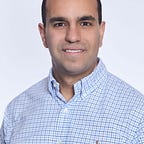Efficiency, security and audit protection through centralized SAM at P&G
When it comes to leading large global projects, Bryant Caldwell knows a thing or two about getting buy-in from leadership to implement transformational projects for managing IT assets around the world. At Rockin’IT we talked to him about the possibilities that SAM offers for efficiency and security, not just for audit protection. We also explore the differences between ITAM and SAM, and how he believes this industry is continuing to evolve on SaaS and Cloud.
Bryant’s background started at the military where he managed fixed assets in a highly structured way, to working for diverse companies like CINTAS, Toyota, Great American Insurance and now back to P&G with the task of advancing their IT Asset Management Program
ITAM and SAM
We wanted to leverage the opportunity of his expertise to clarify the difference between IT asset Management and Software Asset Management. This is seemingly a simple conceptual difference, but we’ve found a few differences in approach and definition across many companies.
“They are complementary and evolutionary at the same time. In the beginning it was ITAM, and SAM wasn’t a thought. When I started there was no such thing, but now 30 years later, SAM is a huge presence, continuing to evolve. It’s already invoking it’s own certifications and audience”
SaaS is overcoming on-premises spend, and it’s growing at such exponential rates that we need to understand how to cost-optimize it and understand it better
Centralized or Federated
Banking on the interview with Liz Reich of Mastercard, we were curious about Bryant’s opinion on Federated SAM, and his point of view is that for a company as geographically distributed as P&G, such programs require normalization, adaptability and centralization for adherence to standards that help make a better outcome.
“To have it federated you’d need to have tight controls that make it difficult. Doing this centraly is by far the most efficient way of doing it, but of course you need to leverage boots on the ground”.
He talks about what kind of people were good candidates for rock star Asset Managers in the past, and how that has changed. “Researchers, curious people that are highly structured” is what he is looking for.
Bryant highlights three things as the main areas of benefit of a proper SAM program: Risk, Cost and Efficiency
When it comes to risk, a proper security posture around software vulnerabilities is key for the organization. Security departments and SAM work together to get great insights on usage and ownership to mitigate risk, including open source and the risks it embeds in organizations if kept unchecked. Obsolescence is one of the most concerning things for CIOs as cited in multiple reports and surveys in the industry.
“The SAM Program we have today is more supportive of the security posture” He mentions that thanks to their current SAM program and tools at P&G they can turn to security and answer who, where and what assets match the profiles of what they are looking for to mitigate vulnerabilities “with surprising level of detail”.
When it comes to efficiency, he looks into how to leverage harvesting opportunities with technology and process, which still is heavy lifting but with the proper tools makes it possible to automate and optimize licensing positions and reclamation.
In Bryant’s opinion, SAM tools today have great interfaces with systems for inventory, scanning, utilization that drive harvesting opportunities that help the conversation between configuration folks and executives to reduce the unneecesary deployment of licenses. He advocates for the industry to implement more efficient, automated ways to leverage these integrations to execute harvesting and has some great ideas on where and how to do it.
Different Industries
One of the interesting things of his carreer is that he’s spent many years “tracking things” — as he describes it- in different industries. From the military where he tracked fix assets, to Toyota, Cintas and Great American Insurance and now back to P&G. In most of these cases, he has built the programs from scratch, so he explores how different verticals and their own needs affect the programs he runs.
“Even though computers and software are the same (mostly), the industry where you play does have an impact into how to operate”
The industry differences lie in some of the relationships between people and technology assets. In some, you may have industrial locations with 1:many relationships, where in others every employee has at least one asset. In other industries you have high computing demand and cycles, like production machines that “run the business” and where your access is scan and monitor is quite limited
Getting Support From The Leadership
Bryant shares his secret to get buy-in and support for your programs and initiatives, which includes having a clear statement of benefits, creating a network to solve problems for different stakeholders, and developing mentorships.
“ To get buy in, it’s a give and take. You need to be a bit of a sales person, showing the benefit to the company in exchange for the budget you are requesting”
On SAM partnerships
Bryant relies on Flexera’s SAM for running his program and has experience with multiple platforms in other organizations.
“Flexera has the deeper flexibility. It helps us do some automation, in terms of measuring license positions. I can take the tool and customize the pieces myself in order to bring more value”.
Words of wisdom
Closing the interview, Bryant described a few points that have helped him in his career:
- Keep things simple. Not all complicated processes are better.
- Never stop learning. Consume information from your environment, but also outside of your scope
- Don’t be afraid to go around. Engage different people and departments, sit with others and create empathy.
Catch up Bryant Caldwell’s full interview on Apple Podcasts, Spotify or any other platform. Subscribe, and follow us on social media.
Go to rockinitpodcast.com for more details.
